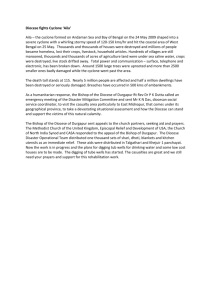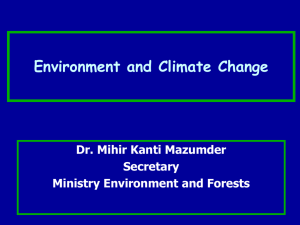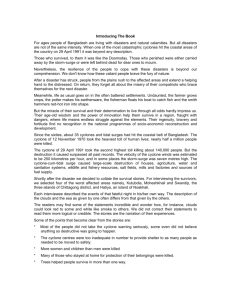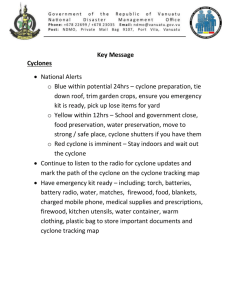Sheikh Rahman
advertisement
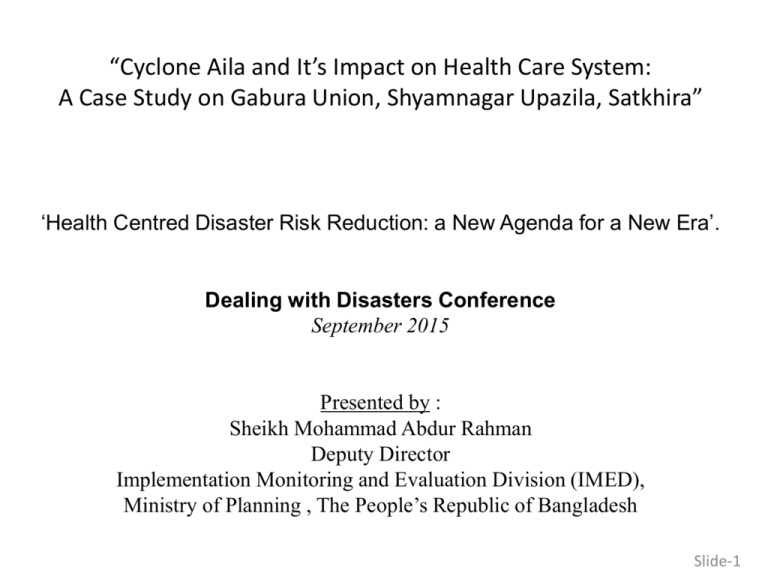
“Cyclone Aila and It’s Impact on Health Care System: A Case Study on Gabura Union, Shyamnagar Upazila, Satkhira” ‘Health Centred Disaster Risk Reduction: a New Agenda for a New Era’. Dealing with Disasters Conference September 2015 Presented by : Sheikh Mohammad Abdur Rahman Deputy Director Implementation Monitoring and Evaluation Division (IMED), Ministry of Planning , The People’s Republic of Bangladesh Slide-1 Brief introduction of my Job Place • • • My job place is Implementation Monitoring and Evaluation Division, Ministry of Planning. I work there as Deputy Director. The major function of this division and as well as my responsibilities are as follows: • Monitoring and Evaluation of the implementation of development projects included in the Annual Development Programme. • Collection and compilation of project-wise data for preparing quarterly, annual and periodical progress reports for information of the President, Prime Minister, NEC, ECNEC, Ministries and other concerned. • Rendering such advisory or consultancy services to Ministries/Agencies concerned on implementation of projects as and when necessary. • Field inspection of projects for on the spot verification of implementation status and such other Co-ordination works as may be necessary for the removal of implementation problems, if any, with the assistance of related Ministries/Agencies. • Submission of project inspection reports to the President, Prime Minister and Ministers concerned when attention at such levels are considered Slidenecessary. Geographic Location of Bangladesh Bangladesh‘s geographical location and land characteristics make it one of the most climatically vulnerable countries in the world (World Bank, 2011). With a population of 157 million people (WPDS, 2013), at least 70% of the population live in regions at risk of floods and 26% in regions at risk of cyclones (Cash et al, 2013). Slide- Some Historic Events of Cyclone in Bangladesh Year Type of hazard Proportion (%) of total region or population affected (n) Height of storm surge (m) Deaths (n) 1970 Bhola Cyclone - 6-10 225000-500000 1985 Cyclone 1.68 million 3-4.6 11000 1991 Cyclone Gorky 4.56 million 6-7.6 138000 2007 Cyclone Sidr 18.3 million 4.5-6.1 2009 Cyclone Aila 3.9 million 2-3 3300 190 Source: Cash et al (2013) Slide- About Cyclone Aila On 23 May 2009, the category 1 cyclone Aila, took shape and hit SouthWestern coastal region on 25 May 2009. The sustained wind speed of the Cyclone Aila was about 65-75 mph (74 mph is the lowest threshold for Cat-1 hurricane). Affected and estimated 3.90 million people in 11 coastal districts of the Bangladesh (ActionAid et al., 2009). Slide- District Satkhira Upazila Shyamnagar Assasuni Khulna Dacope Koira Worst Affected Unions Most Dead Household Affected and Damaged People Missing Gabura 6,007 30,034 24 100% Padmapukur Burigoalini Atulia Protapnagar Sreeula Khazra Baradal Kamarkhola Sutarkhali Tildanga Banisanta Uttar Betkashi 4,432 4,289 4,621 3,750 2,250 2,000 1,875 3,200 8,000 8,000 2,800 4,050 22,163 26,810 28,879 15,000 9,000 8,000 7,500 16,000 40,000 24,000 14,000 8,000 10 5 100% 80% 50% 100% 80% 70% 50% 90% 100% 80% 60% 100% 5,000 5,000 6,204 5,000 76,478 15,000 20,500 25,000 20,000 329,886 47 Dakhin Betkashi Moharajpur Koira Sadar Maheshwaripur Total Most Affected Family 1 4 1 5 100% 80% 50% 70% Massive destruction at Satkhira and Khulna districts caused by Aila Slide-3 Map of Gabura surrounded by Kholpetua and Kopataska rivers specifying with four mouza, health clinic, drinking water source (PSF), roads, market, canals, settlements and others Slide-5 Extent of the impact of Cyclone Aila in Khulna and Sathkira districts Slide-2 Schematic Presentation on Different Facets of Impact Caused by Aila Slide-6 Level Type of facility Type of service Total No. of facilities Upazilla Upazila health complex (50-bed) Hospital 268 Upazila health complex (31-bed) Hospital 145 Upazila health complex (20-bed) Hospital 1 Upazila health complex (10-bed) Hospital 11 Subtotal of Upazila health complexes 425 31-bed hospital Hospital 5 30-bed hospital Hospital 1 Subtotal of hospitals outside health complexes 6 Trauma center (20-bed) Hospital 5 Total of upazila-level hospitals 436 Union 20-bed hospital Hospital 18 10-bed hospital Hospital 13 Subtotal of union-level hospitals 31 Union subcenter Outpatient only 1275 Union health and family welfare center Outpatient only 87 Subtotal of union outpatient centers 1362 Total of union level facilities 1393 Ward Community Clinic Outpatient only 12527 Grand total of hospitals (upazila and below) 467 Grand total of health facilities (upazila and below) 14356 Total beds 13400 4495 20 110 18025 135 30 165 100 18290 360 130 490 490 18780 Primary Health Care run by Directorate General of Health Services at the upazilla level and below Slide-8 Types of facility from national to the ward level, with managerial hierarchy Slide-9 Objectives of the study • • • • To make a clear comparison about health care system of Gabura union before and after Aila; to analyze the situation of the villagers of Gabura in times of disaster and the needs and problems that arose due to the disaster; to examine the weakness of the health care services provided by both GOs and NGOs agencies working for affected villagers of Gabura and To push forward some recommendations so that remedial as well as rehabilitative measures in terms of health and education could be initiated to redress the vulnerability of the affected people. Slide-10 Materials and Methods Data Collection Collection of secondary data from different issues of the daily, monthly and quarterly newspapers, published and unpublished research reports, articles and various relevant web site. Data analysis, appraisal and assessment Collection of primary data through personal interview with the Aila affected inhabitants, traditional birth attendants, village doctors, community leaders, NGO officials, Shyamnagar upazila statistics and health officer. Supported by : Focus Group Discussion & Case Study Study Output Study Design: The Schematic Presentation of Different Steps Followed Slide-11 A view of FGD session conducted in an indigenous way by the researcher with Aila affected male inhabitants in front of Maddho Khalishabunia mosque (situated at Maddho Khalishabunia village) Slide-13 Findings of the study . House of a permanent residence Affected hand of the victims by the tiger Jhupri of the migrants’ family living on the embankment Tiger victims with the researcher Slide-17 Findings of the study In terms of magnitude diseases placed Gabura in the following ranks: Water-borne diseases Cardiovascular diseases Kidney problem High blood pressure/Hypertension Gynecological problem Eclampsia Researcher at village doctor (VD) chamber - 1st Position (100%) - 2nd Position (68%) - 3rd Position (54%) - 4th Position (43%) - 5th Position (36%) - 6th Position (32%) Researcher with Kabiraj Proshanto Slide-21 Water sealed toilet of a permanent residence Non-sanitary toilet of a migrated residence Slide-25 A harvested rain water tank seen to be functioning Homemade harvested rain water tank Water point of a Piped water system PSF water system Homemade harvested rain water tank Piped water system Slide-27 Findings of the study In order to ensure remedy of the diseases the facts are as follows: •The doctor is available only once a week only for a couple of hour. •Bad road infrastructure due to Aila it is difficult on the part of the local people to rush for medical services provided by the four Community Clinics (CCs) specially at the rainy season. • • • • The villagers usually take basic health care services from 38 village doctors or paramedics of Gabura. Village Doctors have their own medicine shop with low quality medicines. Respondents are taking services from Untrained Traditional Birth Attendants and Kabirajs’ even knowing that they are not qualified enough to prescribe any scientific treatment. No health and nutrition related education or campaigning found in the study area. Slide-23 A harvested rain water tank seen to be non-functioning Front view of Friendship water purification system Partial image of Friendship water purification system PSF system installed by OXFAM seen to be non-functioning Front view of Friendship water purification system Partial image of Friendship water purification system Slide-29 Embankment are rebuilt for last five years within this way Embankment and river are almost on the same height in this location Damaged portion of the embankment which is still in risk Only pond that was full of pure water even after more than one year of Aila Slide-31 Signboard of some NGO’s which are exists only in the signboard Slide-33 Concluding Remarks •This particular study was confined to a union only. •The scope for the study was very much limited. •The findings of this study should, at best, be considered as indicative rather than exhaustive. •This micro study will pave the way to take many macro studies in this particular area. • With this study and future research, a nation-wide programs of action could be commissioned aiming at complete rehabilitation of the people (suffering from natural disaster like Aila on regular interval specially health, nutrition and relevant education) living in coastal regions would be viable and sustainable. Slide-34 Researcher with ‘Sheikh Ameer Hossain’ who helps a lot to discover Aila affected Gabura union and assist to communicate all through the respondents Slide-35 Thanks for your patience hearing Do you have any query? Please………………. Contact: Sheikh Mohammad Abdur Rahman Deputy Director Implementation Monitoring and Evaluation Division (IMED), Ministry of Planning , The People’s Republic of Bangladesh Cell No. +8801819260139 E-mail: tinturet@gmail.com Slide-36
